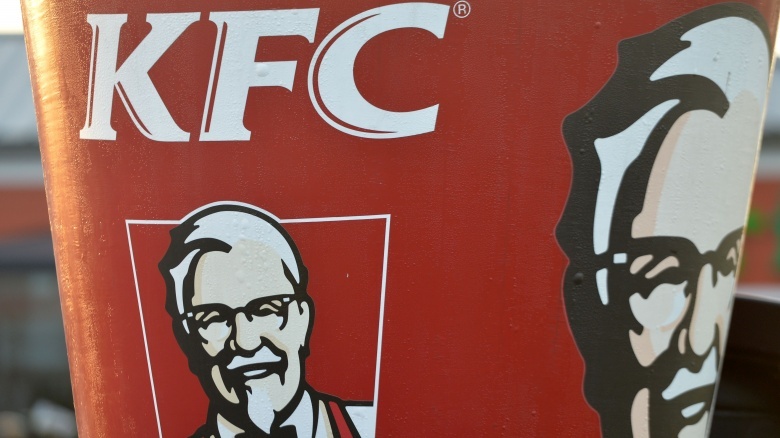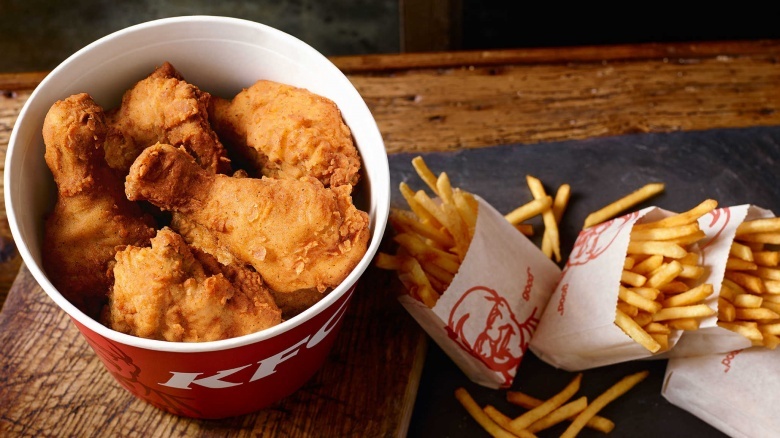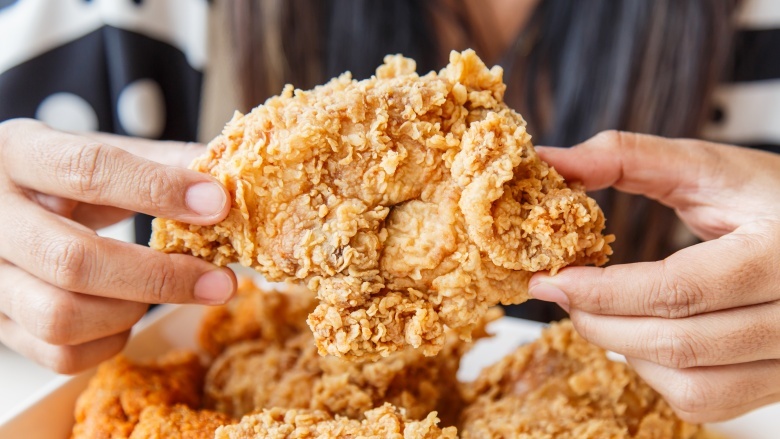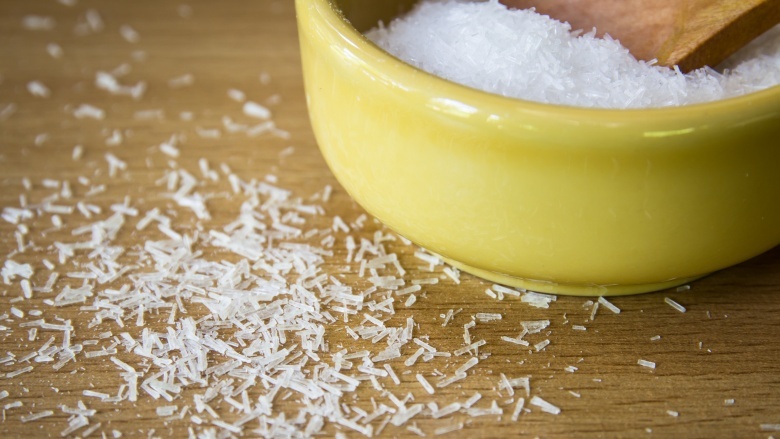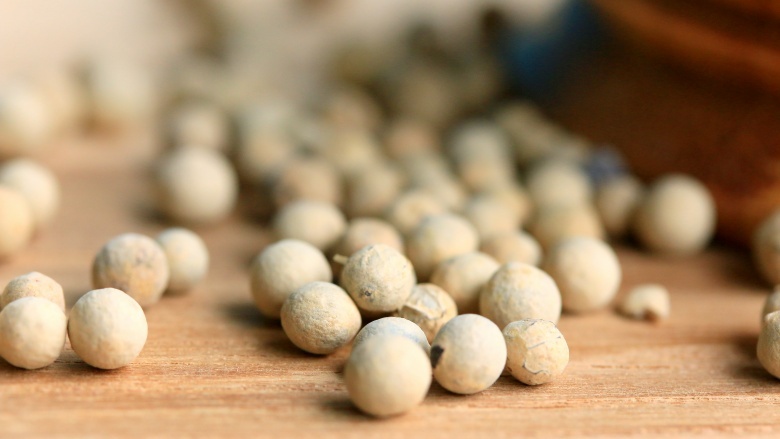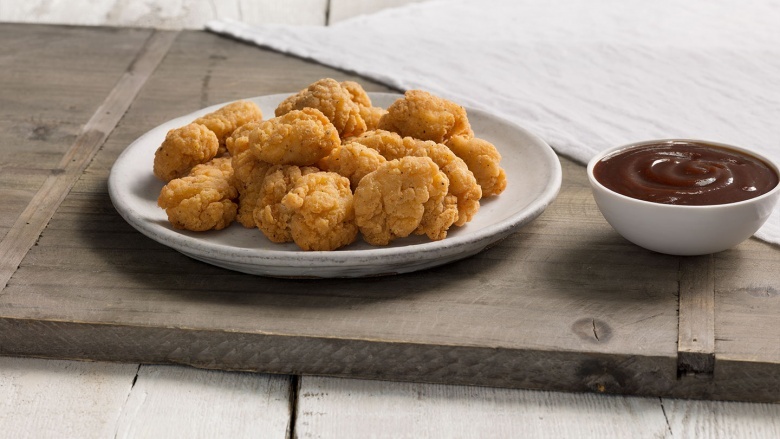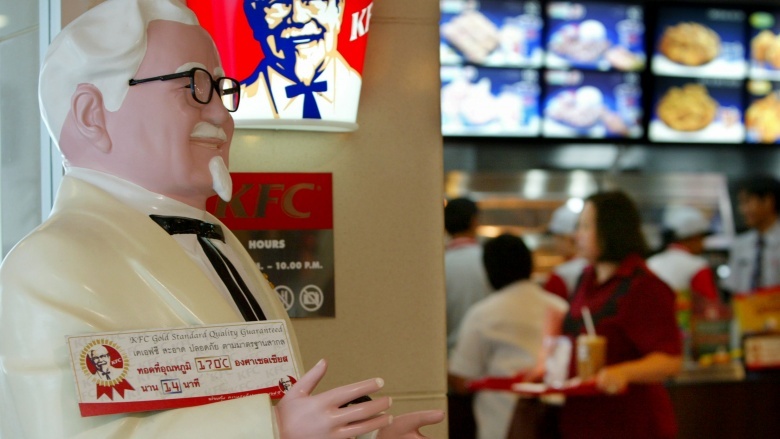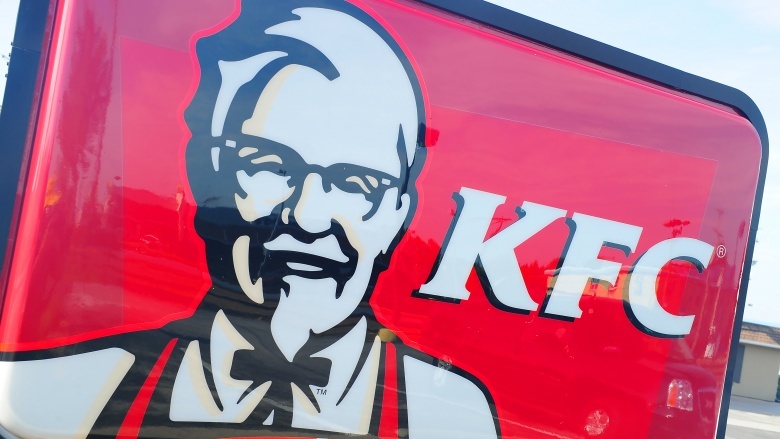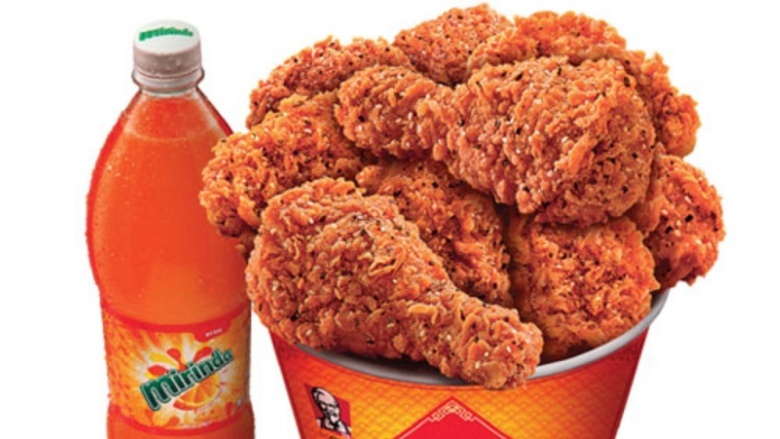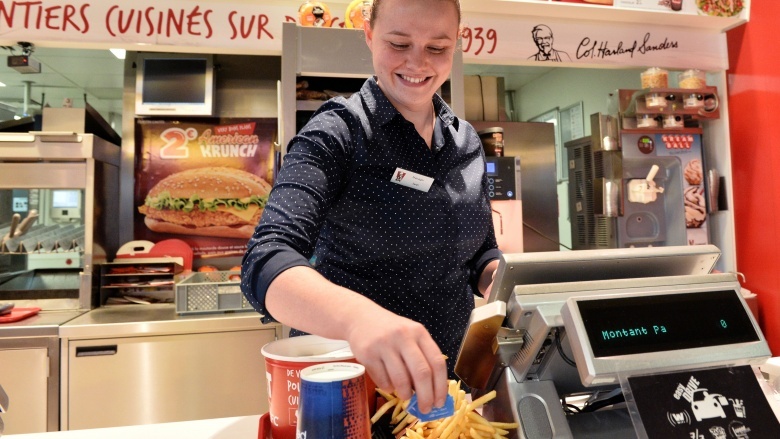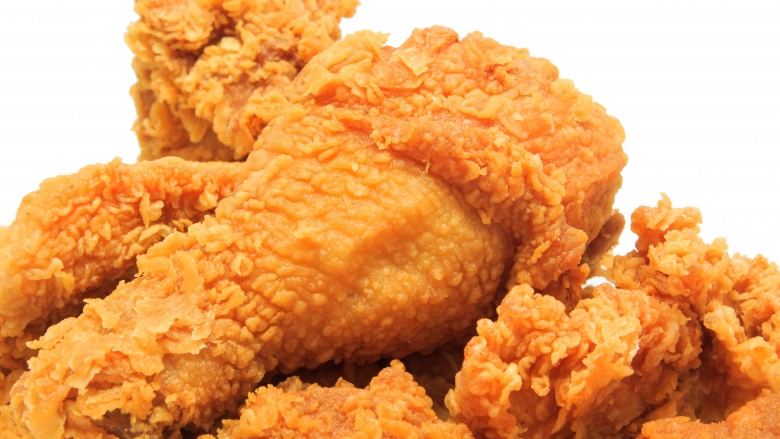What KFC Doesn't Want You To Know
KFC. It's a guilty pleasure that you'll probably regret before you've even made it out the door. But what is it about KFC that keeps you coming back for more, even though you might feel bad afterward, and even though you know it's not at all good for you. That's part of the secret to it, and there's actually a scientific reason that you crave it. Here's what KFC doesn't want you to know.
The secret recipe
This one's so secret that it's right in the name. KFC's success has, of course, been built on its fried chicken, and part of that success comes from their fanatically guarded recipe. It's fried chicken, how complicated can it be, right? Gizmodo's Sploid took a look at how KFC protects the secret recipe, and according to them, the only copy is tucked safely away inside a safe ... that's inside KFC's legal department, that's inside their headquarters. Supposedly only one person knows the safe's combination, which really doesn't seem like a good idea, especially because the recipe is used in most of their meals. Two people know what's in the recipe, which famously consists of 11 herbs and spices. Getting the magic mixture manufactured presents another problem, and Gizmodo also reports that there are two companies that make the fry-batter blend. Each company makes half, then those two parts are combined by a computer.
The secret recipe is great for marketing. But nothing stays secret for long. In August 2016, someone in the KFC camp may have done an "oops."
Did the secret get out?
In August 2016, the Chicago Tribune sent a reporter south to do a story on KFC's original location in Corbin, Kentucky. The reporter met with Joe Ledington, nephew of the infamous Colonel Sanders, and was shown some of the family's extensive memorabilia. Handwritten on the back of the will of Sanders' second wife was a note that specified which 11 herbs and spices were to be blended with two cups of flour for the secret blend. Initially, Ledington said it was the real deal. After it was published in the Tribune, he backtracked to say that he wasn't sure he'd gotten it right. (It was about the only thing he could say, at that point.)
So what's the secret recipe?
You can steal KFC's recipe for your own business
So, you think you're pretty good in the kitchen and you might have this KFC thing down? Let's say you did figure out exactly what the secret KFC recipe is, and you decided that it's so amazing you want to use it in your own chicken joint. There's nothing stopping you from going into business yourself, using the same recipe that you think you've figured out by taste, texture, and repeated experimentation. Even if you're 100 percent right, there's nothing KFC would be able to do about it.
When it came time for KFC to protect their top secret recipe, they could have gone one of two ways. They could have patented it, but patents have some serious drawbacks. All their ingredients, proportions, and preparations would have had to be diagrammed and public, and patents expire. Trade secrets, on the other hand, last as long as everyone can keep their mouths shut. Trade secrets are protected (the Economic Espionage Act of 1996 makes stealing one a federal crime), but different state and national laws makes the legalities of trade secrets a bit sketchy. Protecting them can be difficult, and in order to do so, specifics usually need to be put in front of an open court, defeating the entire purpose anyway.
So if you think you've cracked the KFC recipe, you aren't breaking any rules or regulations if you use it. Just don't go around using their name or logos, and you can make all the cash you want off their recipe.
Oh, so much MSG
KFC does list all its nutritional information on its website, as horrible as it is. The website even has a special diets menu that gives you the option to filter out everything on their menu that includes certain ingredients, like allergens. But if you click on one of them, you aren't left with much choice.
That's MSG, and it's one thing that's missing from most of the knock-off recipes. A menu with all the MSG filtered out only leaves a few sides, desserts, and some drinks so that must be one of the ingredients in their chicken. (Interestingly, one attempt at a knock-off recipe from Ron Douglas included something called Accent. The MSG-based ingredient was a must.) It's in pretty much everything at KFC. The compound was discovered in 1908 and quickly associated with a concept called "umami," or a savory, meaty sort of perfection.
Officially, MSG is generally recognized as safe by the FDA. That may not sound like a glowing review, but the body of scientific evidence shows it's acceptable in reasonable doses for most people. And KFC does let you reverse-hack their menu to avoid, but they aren't going out of their way to advertise it because of public perception.
The science says it's addictive
No one wants to think that they have no control over their cravings. A little investigation into what's behind KFC suggests there's a very scientific reason that you crave it, likely something it doesn't want its customers reasoning their way through.
When Joe Ledington (maybe) let the secret recipe out of the bag, he did say that he specifically remembered white pepper being a huge part of it. When he helped his uncle in the kitchen, he said white pepper was a pretty rare ingredient at the time; most people didn't know how to use it. It seems like that's a given for inclusion in the 11 spices, and if it is? It's potentially addicting, especially in conjunction with other ingredients. White pepper (and black pepper) contains something called piperine, which activates certain sensors in our brains. They're the ones that tell you that you're experiencing a tingling sensation in your mouth, giving pepper its distinctive kick. It's also been identified as having antidepressant qualities (in large enough quantities) and it's thought to help our digestive system do its thing with minimal disturbances. Since you're getting a lot of it at KFC, it's likely that's at least part of what makes your mouth water every time you think of that fried chicken goodness.
The taste is pretty addictive, too
A few other things act together to make KFC particularly addicting. In addition to the MSG and the white pepper, it also contains a huge amount of salt. Get a single chicken breast, and you've got about half your daily requirement of salt already covered. We crave salt. Salt in KFC is about 1.85 percent of the weight of the meal, and not by accident. Compare that with what's in our saliva and what we need in our diet, and it turns out that it hits a sweet-spot ratio for kicking off cravings.
KFC does a few other things right, too. Their particular method for frying means that the distinctive skin delivers flavor faster than regular fried chicken, and the crunch is part of it, too. When Steve Witherly wrote his book on Why Humans Like Junk Food, he had a whole chapter devoted to KFC's tricks for getting people in the door again and again. That skin was a huge part of it, as the different textures of crispy on the outside and juicy on the inside hit a sweet spot in the human palate. We like conflicting textures like that, it's why Oreos are the best cookies in the world, and it's even one reason why we like things like tacos so much. It keeps every part of our brain (and mouth) entertained, and it keeps us wanting more whether it's a good idea or not.
KFC sued Colonel Sanders to shut him up
There are few mascots that are so closely linked to their brand as Colonel Sanders. It's impossible to think of KFC without him, after all, and it seems next to impossible to think that he didn't like what the place had become. After selling KFC, he stayed on as a spokesperson, but seeing someone else take over something you spent a good part of your life perfecting and nurturing is difficult. Harland Sanders seemed incredibly ill-prepared for it.
In 1978, KFC (then Kentucky Fried Chicken of Bowling Green, Inc.) slapped the Colonel with a libel suit over some of the things he said to a reporter at the (Louisville) Courier-Journal. The piece was supposed to be called "Is a chicken wing white meat?" and it contained a whole bunch of hate. When the reporter asked if there was anything that KFC should be doing differently, Sanders first took aim at the gravy. He likened it to paste, and said, "My God, that gravy is horrible. They buy tap water for 15 to 20 cents a thousand gallons and then they mix it with flour and starch and end up with pure wallpaper paste. And I know wallpaper paste, by God, because I've seen my mother make it." If you're hoping he had nicer things to say about the chicken, you'd be disappointed. Sanders called it, "nothing in the world but a damn fried doughball stuck on some chicken."
No one wants their product described like that, except for purveyors of wallpaper paste. Surprisingly, the courts sided with Sanders and argued that his remarks were general enough that they weren't actually defaming anyone and that the recipe had, in fact, changed from what he had originally established KFC as. The suit was dismissed, but the bitterness probably lasted a while.
Claudia Sanders Dinner House and the real recipes
The last thing KFC wants is people questioning the tradition of the food, but some of the recipes served today are not like the originals. As more and more restaurants were added to the KFC family, execs realized that some of the recipes (the gravy included) were just too complicated to be executed affordably, cheaply, and by people who weren't necessarily trained chefs. When the recipes were dumbed down, the Colonel decided to open his own restaurant as a protest. Even as he continued to smile for the camera for KFC (and take home a nifty $250,000 a year), he and his wife opened The Colonel's Lady's Dinner House, a direct shot at KFC.
Not surprisingly, everyone went to court again. Sanders was eventually awarded a $1 million settlement as long as he agreed to rename the restaurant to distance it from KFC and to stop saying anything bad about the KFC brand. The dinner house became Claudia Sanders Dinner House (and it's still around), and the Colonel had to keep his opinions to himself about what he really thought about the changes to his original recipes.
It's still fried chicken
If you're of a certain age, you probably remember when the chain was called Kentucky Fried Chicken. Now you'll only see it branded as KFC. Technically, the two have nothing to do with each other. For real. Listen to some of the newer commercials, and you'll hear the phrase "kitchen-fresh chicken" repeated, as if that's the new KFC? What gives?
Check out the name change history on its official website and it comes off a little defensive. It says the name change was to make it clear that it was offering more than just chicken, but conspiracy theorists started circulating the story that they were legally obligated to remove the word "chicken" from their name, because they weren't actually serving chickens, but mutant chickens. Hoax photos (and yes, they were definitely hoaxes) started circulating and proclaiming that they showed mutant chickens, bred with extra wings and legs, just for serving at KFC.
The real word it didn't want you to know or think of is "fried." Bloomberg reported the name change was part of a rebranding in an attempt to make the chain at least seem healthier. KFC gave the name a makeover, hid "fried" from common parlance, and tried to give itself a new image without really admitting it, even on its own website.
Is KFC's food healthy now?
Let's head back to that nutritional guide we mentioned earlier. It lets you build a meal to see what your choices are going to mean for your diet, but that's not entirely fair. There's no pictures, for one thing, and everyone knows you're going to be picking entirely different things when you're in the restaurant faced with that smell and those crispy buckets. But, for the benefit of the doubt, say you're going to order a side of coleslaw and a biscuit, along with a chicken on the bone breast and thigh. Add a 20 oz. Dr. Pepper and a chocolate chip cookie for good measure, and what do you have?
That comes to 1,360 calories, 64 grams of fat, and a heart-stopping 2,780 mg of sodium. Sure, you're eating out, so you expect that. What they don't want you to know? It's absolutely unnecessary. Take this recipe from The Food Network. If you're craving that crispy goodness, try swapping out KFC's artery-clogging fried heaviness with something that has all the spices but replaces frying with baking, and uses lowfat yogurt and corn cereal for the crispy, crunchy crust. Lower calories? Less fat? Less sodium? Fried chicken might not be the best for you, but you can definitely get your fix without making yourself feel horrible for the rest of the day. Would Colonel Sanders like it? Hard to say, but he might prefer it to what KFC is today.
(Maybe) KFC's secret recipe
All right, all right! No guarantees on this, but it's as close as it gets right now. Even though KFC tried to crack down and do some damage control to protect their secret, the leaked recipe is reportedly pretty spot-on when it comes to replicating the taste KFC fans hate to love.
It reads:
11 spices – Mix With 2 Cups White Fl.
⅔ Ts Salt
½ Ts Thyme
½ Ts Basil
⅓ Ts Origino
1 Ts Celery Salt
1 Ts Black Pepper
1 Ts Dried Mustard
4 Ts Paprika
2 Ts Garlic Salt
1 Ts Ground Ginger
3 ts White Pepper
And that's it, exactly as written, misspellings and all. According to the Tribune, when they tried the recipe with a few updated modifications to the method of cooking, it was pretty spot-on. (They also found that the odd way of writing "Ts" actually meant "tablespoons," not teaspoons. A spokesperson from KFC issued a statement saying that there have been a lot of people who have thought they had it right, but that no one had been successful so far. Whether that's actually true or not, you'll have to judge.
If you take a look at some of the knock-off recipes that have been floating around, you'll see some major discrepancies between them. This one from Food.com includes things like nutmeg, vanilla bean, cardamom, sage, and coriander, none of which show up on the "official" version. Epicurious suggests that it includes chili powder, sage and marjoram, which are also not in this new version. What does that mean for the authenticity of any of these recipes? No one knows; give them a try!
